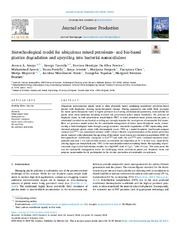Приказ основних података о документу
Biotechnological model for ubiquitous mixed petroleum- and bio-based plastics degradation and upcycling into bacterial nanocellulose
| dc.creator | Araujo, Jeovan A. | |
| dc.creator | Taxeidis, George | |
| dc.creator | Pereira, Everton H. | |
| dc.creator | Azeem, Muhammad | |
| dc.creator | Pantelić, Brana | |
| dc.creator | Jeremić, Sanja | |
| dc.creator | Ponjavić, Marijana | |
| dc.creator | Chen, Yuanyuan | |
| dc.creator | Mojicević, Marija | |
| dc.creator | Nikodinović-Runić, Jasmina | |
| dc.creator | Topakas, Evangelos | |
| dc.creator | Brennan Fournet, Margaret | |
| dc.date.accessioned | 2024-02-10T20:22:36Z | |
| dc.date.available | 2024-02-10T20:22:36Z | |
| dc.date.issued | 2024 | |
| dc.identifier.issn | 0959-6526 | |
| dc.identifier.uri | https://www.sciencedirect.com/science/article/pii/S0959652624004724 | |
| dc.identifier.uri | https://imagine.imgge.bg.ac.rs/handle/123456789/2315 | |
| dc.description.abstract | Ubiquitous post-consumer plastic waste is often physically mixed combining recalcitrant petroleum-based plastics with bioplastics, forming (petro-bio)plastic streams. Finding appropriate end-of-life (EoL) strategies for mixed (petro-bio)plastic waste is highly pertinent in achieving environmental protection, sustainability for plastic value chain industries including recyclers and government policy makers worldwide. The presence of bioplastic mixed in with polyethylene terephthalate (PET) or other petroleum-based plastic streams poses a substantial drawback to mechanical recycling and strongly impedes the development of sustainable EoL routes. Here, we present a model system for the sustainable management of mixed (petro-bio)plastic waste, demonstrating a biotechnological route through synergy-promoted enzymatic degradation of PET–representing petrochemical polyester plastic–mixed with thermoplastic starch (TPS)–as a model bioplastic. Leaf-branch compost cutinase (LCCICCG) and commercial amylase (AMY) deliver effective depolymerization of this mixed (petro-bio)plastic material, with subsequent bio-upcycling of the mixed waste stream into bacterial nanocellulose (BNC) by Komagataeibacter medellinensis. Compared to LCCICCG and AMY, the LCCICCG/AMY combined treatment synergistically produced a 2.6- and 4.4-fold increase in enzymatic decomposition at 70 °C in four days, respectively, yielding sugars and terephthalic acid (TPA) as the main depolymerization building blocks. Bio-upcycling of post-enzymatic degradation hydrolysates resulted in a high BNC yield of 3 g L−1 after 10 days. This work paves the way for sustainable management routes for challenging mixed recalcitrant plastic and bioplastic waste and prepares opportunities for its participation in the circular production of sustainable eco-polymers. | |
| dc.publisher | Elsevier | |
| dc.relation | European Union’s Horizon 2020 Research and Innovation 749 program [grant number: 870292 (BioICEP) | |
| dc.relation | European Union’s Horizon Europe EIC 750 Pathfinder program [grant number: 101046758 (EcoPlastiC) | |
| dc.rights | openAccess | |
| dc.rights.uri | https://creativecommons.org/licenses/by/4.0/ | |
| dc.source | Journal of Cleaner Production | |
| dc.subject | Bio-upcycling | |
| dc.subject | Biodegradation | |
| dc.subject | Eco-polymers production | |
| dc.subject | Enzymatic synergism | |
| dc.subject | Mixed plastic waste | |
| dc.subject | Plastic waste valorization | |
| dc.title | Biotechnological model for ubiquitous mixed petroleum- and bio-based plastics degradation and upcycling into bacterial nanocellulose | |
| dc.type | article | en |
| dc.rights.license | BY | |
| dc.citation.spage | 141025 | |
| dc.identifier.doi | 10.1016/j.jclepro.2024.141025 | |
| dc.identifier.fulltext | https://imagine.imgge.bg.ac.rs/bitstream/id/711518/1-s2.0-S0959652624004724-main.pdf | |
| dc.type.version | publishedVersion |

